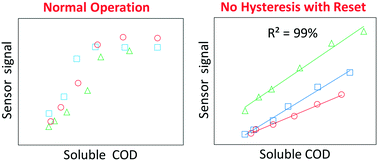当前位置:
X-MOL 学术
›
Environ. Sci.: Water Res. Technol.
›
论文详情
Our official English website, www.x-mol.net, welcomes your feedback! (Note: you will need to create a separate account there.)
Accurate and rapid organic detection by eliminating hysteresis in bioanode sensor applications
Environmental Science: Water Research & Technology ( IF 5 ) Pub Date : 2017-07-13 00:00:00 , DOI: 10.1039/c7ew00115k Pengyi Yuan 1, 2, 3, 4 , Younggy Kim 1, 2, 3, 4
Environmental Science: Water Research & Technology ( IF 5 ) Pub Date : 2017-07-13 00:00:00 , DOI: 10.1039/c7ew00115k Pengyi Yuan 1, 2, 3, 4 , Younggy Kim 1, 2, 3, 4
Affiliation

|
Bioanode sensors utilizing exoelectrogenic bacteria can be used for real-time and in situ assessment of water quality. The main challenges for practical applications of bioanode sensors in water quality assessment include their narrow detection range, long analysis time, and hysteresis effects. To overcome these limitations, a new operation method was proposed and examined in microbial electrolysis cell (MEC)-based bioanode sensors. The new operation method consists of normal operation (0.6 V application), a reset step (1.8 V application for 1 min), and a test step (1.2 V application for 2 min). The inclusion of the reset step in the sensor operation eliminated potential hysteresis effects and thus resulted in accurate correlations between readily biodegradable COD (chemical oxygen demand) and electric current with consistent R2 values of 99% in triplicated sensor experiments. The high voltage application (1.2 V) during the test step not only enhanced sensor accuracy but also extended the detection range up to 130 mg-COD L−1. The combination of a reset step and a test step was proven to allow reliable sensor applications of MECs and other bioelectrochemical systems. Even with the greatly improved sensor accuracy, the correlation between readily biodegradable COD (acetate) and electric current varied substantially in 2 days. The findings indicate that bioanode sensors can be used for rapid organic detection in 3 min with very high accuracies but require frequent sensor calibration.
中文翻译:

通过消除生物阳极传感器应用中的磁滞现象,进行准确,快速的有机检测
利用外生电细菌的生物阳极传感器可用于实时和原位水质评估。生物阳极传感器在水质评估中的实际应用面临的主要挑战包括其检测范围窄,分析时间长和滞后效应。为了克服这些限制,提出了一种新的操作方法,并在基于微生物电解池(MEC)的生物阳极传感器中进行了研究。新的操作方法包括正常操作(施加0.6 V电压),复位步骤(施加1.8 V电压1分钟)和测试步骤(施加1.2 V电压2分钟)。在传感器操作中包括复位步骤,消除了潜在的磁滞效应,因此在具有恒定R 2的易于生物降解的COD(化学需氧量)与电流之间产生了精确的相关性一式三份的传感器实验中的99%值。在测试步骤中施加高电压(1.2 V)不仅提高了传感器的精度,而且将检测范围扩展至130 mg-COD L -1。重置步骤和测试步骤的组合被证明可以实现MEC和其他生物电化学系统的可靠传感器应用。即使大大提高了传感器的精度,易生物降解的COD(乙酸盐)与电流之间的相关性在2天之内也发生了很大变化。研究结果表明,生物阳极传感器可在3分钟内以极高的准确度用于有机物的快速检测,但需要经常进行传感器校准。
更新日期:2017-08-24
中文翻译:

通过消除生物阳极传感器应用中的磁滞现象,进行准确,快速的有机检测
利用外生电细菌的生物阳极传感器可用于实时和原位水质评估。生物阳极传感器在水质评估中的实际应用面临的主要挑战包括其检测范围窄,分析时间长和滞后效应。为了克服这些限制,提出了一种新的操作方法,并在基于微生物电解池(MEC)的生物阳极传感器中进行了研究。新的操作方法包括正常操作(施加0.6 V电压),复位步骤(施加1.8 V电压1分钟)和测试步骤(施加1.2 V电压2分钟)。在传感器操作中包括复位步骤,消除了潜在的磁滞效应,因此在具有恒定R 2的易于生物降解的COD(化学需氧量)与电流之间产生了精确的相关性一式三份的传感器实验中的99%值。在测试步骤中施加高电压(1.2 V)不仅提高了传感器的精度,而且将检测范围扩展至130 mg-COD L -1。重置步骤和测试步骤的组合被证明可以实现MEC和其他生物电化学系统的可靠传感器应用。即使大大提高了传感器的精度,易生物降解的COD(乙酸盐)与电流之间的相关性在2天之内也发生了很大变化。研究结果表明,生物阳极传感器可在3分钟内以极高的准确度用于有机物的快速检测,但需要经常进行传感器校准。



























 京公网安备 11010802027423号
京公网安备 11010802027423号